Dierama dubium
Dierama dubium N.E.Br.
Family: Iridaceae
Common names: hidden hairbell (Eng.); grasklokkie (Afr.)
Introduction
A little-known and seldom seen, perennial, evergreen geophyte with small, nodding dark purple-red flowers and white bracts which are borne on arching stems in spring to midsummer, only found growing in grassland in a small part of central KwaZulu-Natal.
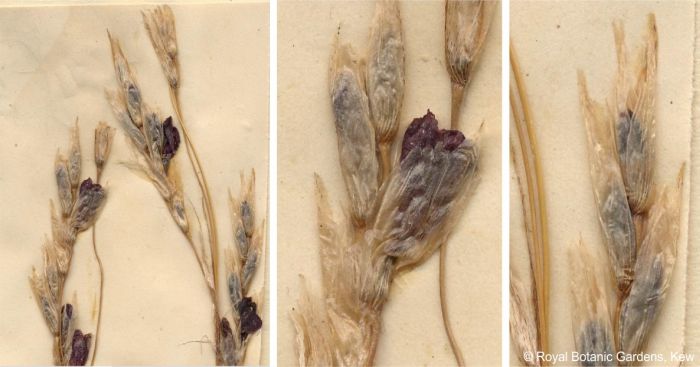
Description
Description
An evergreen perennial with a cormous rootstock, giving rise to slender, sword-shaped leaves that are 400-850 mm long and 3-5 mm wide. Dierama dubium has linear leaf blades with longitudinal veins in the leaves while lacking a midrib. They produce small bell-shaped flowers that, when the plant is flowering, cause the branching stem to bend. The flowers are pendulous and are borne on a single stem that is 750-1500 mm long. The flowers are dark purple-red, the perianth 14-18 mm long. The bracts are white to lightly flecked and 16-24 mm long and 5-8 mm wide. The flowers are normally shorter than the bracts enfolding the flower. Dierama dubium flowers have 3 stamens, an inferior ovary and stigmas held just below the top of the perianth.
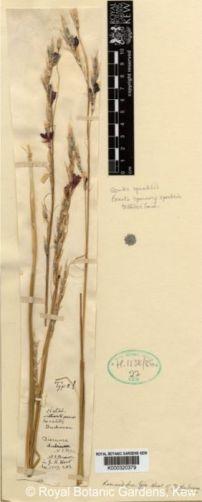
Dierama dubium is similar to Dierama argyreum which has white flowers, but its flowers are smaller, more crowded and dark purple-red and their ranges don’t overlap. It is also similar to Dierama latifolium, which is found growing in large clumps and has wider leaves. This species produces pink to deep red flowers with white bracts, borne on long, arching stems. It is also, closely related to Dierama reynoldsii which is distinguished by its taller stems, and it has larger, deep red to purple flowers with larger silvery white bracts that are not flecked, in spring.
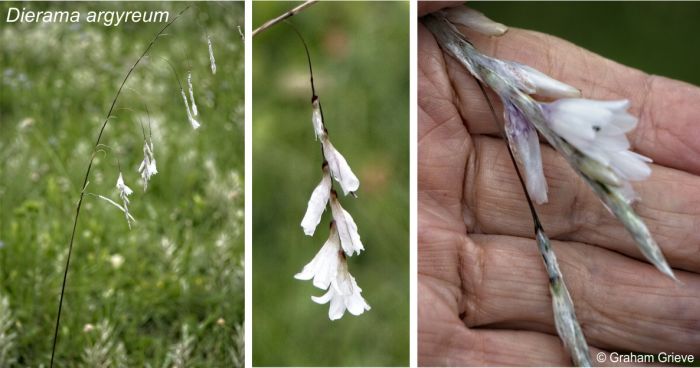
Conservation Status
Status
According to the Red List of South African Plants, Dierama dubium has been assessed with the conservation status Vulnerable (VU) due to it being a rare species which occurs in low numbers and is known from just 5-7 localities and the grassland habitats where this species occurs in KwaZulu-Natal are being transformed. The transformation is mainly caused by agriculture, forestry and currently overgrazing on lands leaving the soil mostly vulnerable to soil erosion, as a result their distribution in their natural habitat has been reduced and suitable habitat is limited within their natural range.
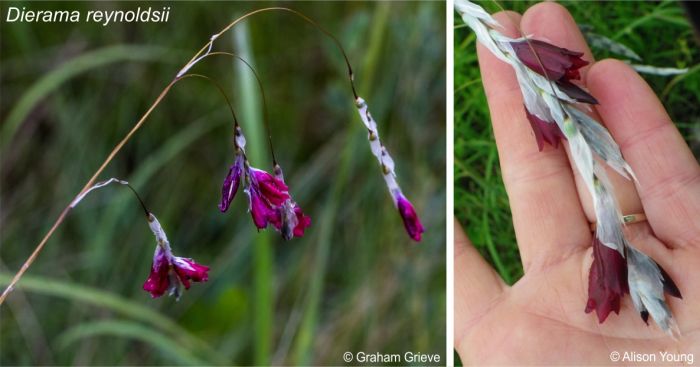
Distribution and habitat
Distribution description
Dierama dubium is naturally distributed in Midlands Mistbelt Grassland and Moist Coast Hinterland Grassland vegetation types in the midlands of KwaZulu-Natal where the climate is mostly temperate. They are found growing in these regions at 1 200 to 1 500 m above sea level. The mistbelt grasslands are a home to species that are adapted to fires, making Dierama dubium a species that can survive fire, although they need to be managed as too frequent fire can reduce their numbers. Also, in its natural habitat, Dierama dubium usually experiences misty mornings.
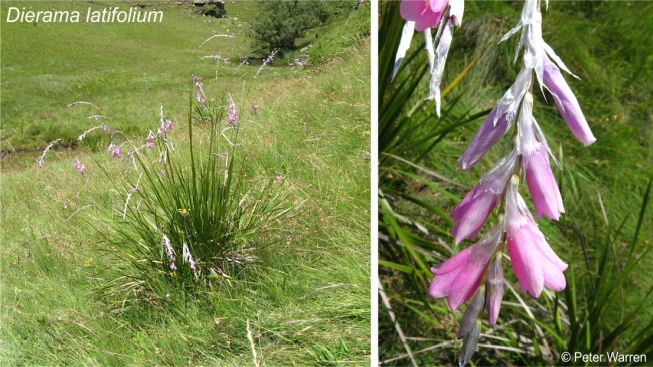
Derivation of name and historical aspects
History
The genus name Dierama is derived from a Greek word that means ‘funnel’ referring to the shape of the flower. The species name dubium means ‘dubious’, ‘doubtful’ or ‘uncertain’, because the botanist N.E. Brown who named it was at first not sure if it was a distinct species or just a different colour form of D. argyreum.
This species does not have a known common name but, Dierama species are commonly known as hairbell, angel’s fishing rod, fairy bell and wandflower, or grasklokkie, an Afrikaans word that means ‘grass-bell’ which describes the grass-like nature of the leaves and stems and the bell-shaped flowers. We propose ‘hidden hairbell’ for the common name, because the flowers are somewhathidden by the bracts and its rare and sparse nature keep it hidden from us and we have been unable to find a photo of it.
Dierama dubium is a species endemic to South Africa from Iridaceae, a geophytic family with only four subfamilies recognized in South Africa. It consists of approximately 82 genera and 1 800 species in the world and about 45 species of Dierama . This family occurs in tropical and temperate regions of the world, and in southern Africa they are mostly found distributed in winter-rainfall areas. Species from this family play a vital role in cut flower production, many are used in garden designs, and some members used for food production.
Ecology
Ecology
The specific pollinator of Dierama dubium is not known, but flowers of the Dierama genus are mostly pollinated by bees. Dierama dubium is a species that grows in grassland biomes and can withstand fire by retreating underground during veld fire. Since they have a corm, which is a tuberous storage organ, the essential nutrients and energy needed for its growth are stored in their root systems and kept safe underground, and are released when the the plant grows back and resprouts after the fire.
Uses
Use
Dierama dubium is a rare species with no known traditional uses, but species from this genus have been used for medicinal practices to treat stomach problems, while others grown for ornamental purposes, and used in cutflower production. The dark purple-red flowers and their evergreen leaves would make this plant a good addition to have as part of cultivated nursery stock. Dierama ambiguum, D. erectum and D. nixonianum are the most endangered species from this genus yet have the most important uses and cultural practices to serve.
Growing Dierama dubium
Grow
There are no known cultivation records on Dierama dubium, but it is a species from an easy to grow genus that needs little maintenance. Dieramas are propagated from seed or division of clumps. Sow Dierama seeds in spring using a fertile soil medium, that will retain moistureyet be well-drained, preferably loamy soil, to prevent drying during summer. One can use a container or sow directly in the ground. Give seeds space in between to allow for seeds to germinate and develop freely. Place the sown seeds in a frost-free location. Some Dierama species being grown under these conditions will germinate within the first two weeks of being sown.
If grown vegetatively, lift and divide clumps in spring ensuring that the roots are not damaged. Remove or trim the foliage to prevent loss of water where needed. Replant the divided clumps in a well-drained medium then place in a position where it is exposed to the sun. If planted directly in the ground, apply compost at the top level mixing it with the soil. Their elegant flowers makes them the best plants for gravel garden, planted on garden borders and make an ideal combination with ornamental grasses. Dierama species are most likely to be affected by Aphids therefore, when growing this species be on the lookout of this pest.
References
- De Jong, G. 2016-2024. Dierama dubium. Dierama. Engelhengel/Angel’s Fishing Rods. Online. https://www.dierama.nl/soorten-species-1/d/dubium. Accessed 5 Jul. 2024.
- Hugh, G. 2005. Dierama reynoldsii I.Verd. (Iridaceae). PlantZAfrica. Online. http://pza.sanbi.org/dierama-reynoldsii
- Grieve, G. 2019. Observation of Dierama reynoldsii, Jolivet, KZN. iNaturalist. Online. https://www.inaturalist.org/observations/117723766.
- Grieve, G. 2024. Observation of Dierama argyreum, St James Parish, East Griqualand, KZN. iNaturalist. Online. https://www.inaturalist.org/observations/195904628.
- Hilliard, O.M. & Burtt, B.L. 1991. Dierama, the hair bells of Africa. Acorn Books, Johannesburg & London.
- JSTOR Global Plants. Type specimen of Dierama dubium N.E.Br. https://plants.jstor.org/stable/10.5555/al.ap.specimen.k000320379. Downloaded 22 July 2024.
- Koekemoer, M., Steyn, H.M. & Bester, S.P. 2015. Guide to Plant Families of southern Africa. Strelitzia 31. 2nd ed., 2nd print. South African National Biodiversity Institute, Pretoria, South Africa.
- Manning, J. 2004. Iridaceae. PlantZAfrica. Online. https://pza.sanbi.org/iridaceae.
- Ndlovu, B. 2019. Dierama tysonii N.E.Br. (Iridaceae). PlantZAfrica. Online. https://pza.sanbi.org/dierama-tysonii.
- Plants of the World Online. Dierama dubium N.E.Br. https://powo.science.kew.org/taxon/436837-1. Accessed 5 Jul. 2024.
- RHS. How to grow dierama. RHS Growing Guide. Online. https://www.rhs.org.uk/plants/dierama/growing-guide. Accessed 5 Jul. 2024.
- Von Staden, L., Victor, J.E. & Scott-Shaw, C.R. 2006. Dierama dubium N.E.Br. National Assessment: Red List of South African Plants. Accessed on 2024/07/03.
- Warren, P.2008. Observation of Dierama latifolium, Umgungundlovu KZN. iNaturalist. Online. https://www.inaturalist.org/observations/37453070.
- Wentzel, J. 2017. Grassland Garden Maintenance. Wildflower Blog. Online. https://www.randomharvest.co.za/News-Blog/Wildflower-Blog/entryid/142/grassland-garden-maintenance.
- Young, A. 2013 Observation of Dierama reynoldsii, Ixopo, KZN. iNaturalist. Online. https://www.inaturalist.org/observations/10936138.
Credits
Mlondi Skhosana & Charlotte Sindiswa Ntenga
KwaZulu-Natal National Botanical Garden
August 2024
Acknowledgements: Herbarium specimen courtesy of the Royal Botanic Gardens Kew, downloaded from JSTOR Global Plants. Images by Graham Grieve, Peter Warren and Alison Young, from their observations posted on iNaturalist.
Plant Attributes:
Plant Type: Bulb
SA Distribution: KwaZulu-Natal
Soil type: Sandy, Loam
Flowering season: Early Summer
PH: Acid
Flower colour: Purple, Red
Aspect: Full Sun
Gardening skill: Average
Special Features:
Horticultural zones







Rate this article
Article well written and informative
Rate this plant
Is this an interesting plant?
Login to add your Comment
Back to topNot registered yet? Click here to register.